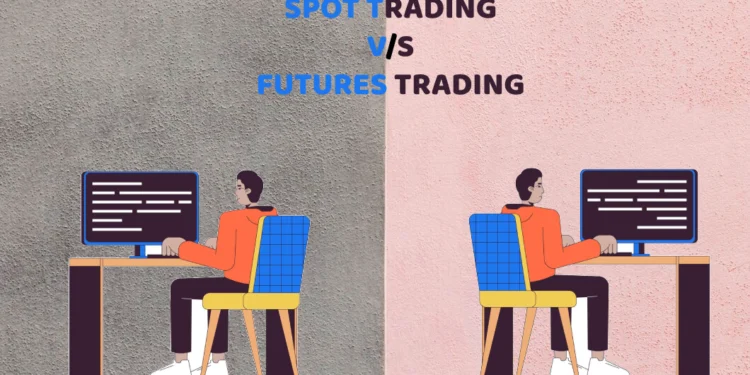When it comes to crypto trading, understanding the differences between spot trading and derivatives trading (like futures trading) is crucial. Whether you’re a beginner or an experienced trader, platforms like Bybit offer advanced tools and features for both types of trading. In this guide, we’ll break down these two strategies, explain how they work, and help you choose the right one for your needs.
What is Spot Trading?
Spot trading is the simplest form of trading, where you buy and sell assets (like Bitcoin, Ethereum, or other cryptocurrencies) at the current market price, with immediate settlement. You own the actual asset and can hold it or sell it whenever you want.
Key Features of Spot Trading:
- Immediate Ownership: You get full ownership of the asset once purchased.
- No Leverage: You trade with the funds you have in your account.
- Lower Risk: You can only lose the amount you’ve invested, with no risk of liquidation.
Example: If you buy 1 BTC on Bybit at $30,000, you own that Bitcoin. You can hold it and sell it when the price increases for a profit.
How to Profit from Spot Trading:
- Buy Low, Sell High: This is the standard strategy in spot trading. Buy when prices are low and sell when they rise.
- Dollar-Cost Averaging (DCA): Invest a fixed amount regularly, regardless of the market’s price fluctuations, to minimize the impact of volatility.
Bybit’s spot trading platform offers competitive fees, high liquidity, and access to a wide range of cryptocurrencies for trading. It’s a great place to start for beginners and experienced traders alike. Sign up now on Bybit with this link.
What is Derivatives (Futures) Trading?
In derivatives trading, you don’t actually own the underlying asset. Instead, you trade contracts that are based on the value of an asset, like Bitcoin or Ethereum. Bybit’s derivatives trading platform allows you to use leverage, meaning you can open positions much larger than your initial investment.
Key Features of Derivatives Trading:
- Leverage: Control large positions with a small investment, which can amplify profits or losses.
- Speculation: Traders can go long (bet that the price will rise) or short (bet that the price will fall).
- No Ownership: You’re trading contracts based on the asset, not the asset itself.
Example: Suppose you go long on a Bitcoin futures contract at $30,000 with 10x leverage. If the price rises to $33,000, you’ll earn a 30% profit on your initial investment.
How to Profit from Derivatives Trading:
- Leverage Trading: Amplify your returns by using leverage. With 10x leverage, a 10% price increase can result in a 100% profit on your margin.
- Short Selling: Bet on the price going down to profit during bear markets.
- Hedging: Use derivatives to hedge against potential losses in the spot market.
Bybit’s futures trading platform offers up to 100x leverage, making it an attractive choice for advanced traders looking to maximize their returns. Start trading on Bybit today.
Spot Trading vs. Derivatives Trading: Key Differences
| Feature | Spot Trading | Derivatives Trading |
|---|---|---|
| Ownership | You own the asset | You trade contracts, no ownership |
| Leverage | No leverage | High leverage (up to 100x on Bybit) |
| Risk | Lower risk, only lose what you invest | Higher risk, potential liquidation |
| Objective | Long-term holding and value growth | Short-term speculation and hedging |
| Profit Potential | Profit only from price increase | Profit from both price increase and drop |
Both types of trading have their advantages. Spot trading is great for investors who want to hold actual assets, while derivatives trading is suited for traders looking to profit from price movements, regardless of market direction.
Risks in Derivatives Trading
While derivatives trading offers high-profit potential, it also comes with increased risk. With leverage, even small market movements can result in significant gains or losses.
Risks to Consider:
- Liquidation: If the market moves against your leveraged position, your entire margin could be wiped out.
- Market Volatility: Cryptocurrencies are highly volatile, making derivatives trading riskier, especially with high leverage.
Risk Management Tips:
- Use Stop Losses: Set stop losses to minimize potential losses on your trades.
- Use Leverage Wisely: Avoid high leverage if you’re new to trading, and only trade with what you can afford to lose.
Bybit offers tools like stop-loss orders and risk management features to help you protect your capital. Trade derivatives on Bybit.
Best Practices for Spot and Derivatives Trading
- Diversification: Don’t put all your capital into one trade. Diversify between spot and derivatives to balance risk and reward.
- Stay Informed: Keep up with the latest crypto news and market trends to make informed trading decisions.
- Risk Management: Set clear risk-reward ratios for each trade to ensure you’re not risking more than you can afford to lose.
Platforms like Bybit offer educational resources, in-depth market analysis, and 24/7 support to help traders succeed. Whether you’re into spot trading or want to take advantage of futures markets, Bybit is a comprehensive platform that suits both beginners and advanced traders.
Whether you prefer spot trading or derivatives trading, both offer unique opportunities in the cryptocurrency market. For long-term investors, spot trading is a safer and simpler approach. On the other hand, derivatives trading, especially with Bybit’s futures platform, allows traders to speculate and potentially earn profits in both rising and falling markets.
For the best of both worlds, many traders use a mix of spot and derivatives strategies to diversify their portfolios. Whatever your preference, Bybit provides a secure, user-friendly platform with competitive fees and advanced tools for all types of traders. Get started on Bybit today and explore the world of crypto trading.




